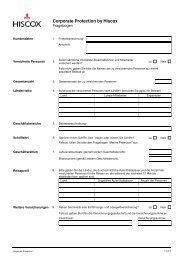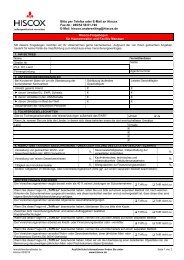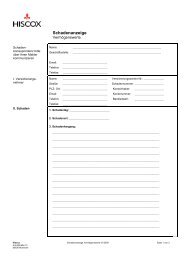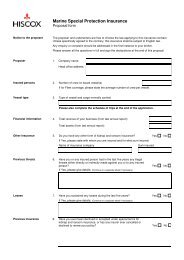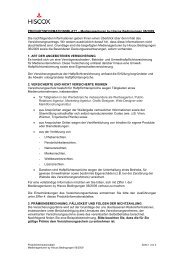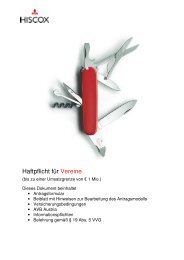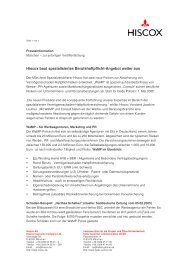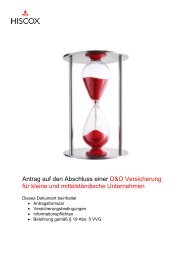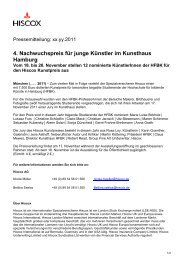Download PDF - Hiscox
Download PDF - Hiscox
Download PDF - Hiscox
You also want an ePaper? Increase the reach of your titles
YUMPU automatically turns print PDFs into web optimized ePapers that Google loves.
2 Significant accounting policies continued<br />
2.9 Impairment of assets continued<br />
(c) Impairment loss continued<br />
amount exceeds its recoverable amount.<br />
The recoverable amount is the higher of<br />
an asset’s fair value less costs to sell and<br />
value in use. For the purpose of assessing<br />
impairment, assets are grouped at the<br />
lowest levels for which there are separately<br />
identifiable cash flows (cash generating units).<br />
Where an impairment loss subsequently<br />
reverses, the carrying amount of the asset<br />
is increased to the revised estimate of<br />
its recoverable amount, but so that the<br />
increased carrying amount does not<br />
exceed the carrying amount that would<br />
have been determined had no impairment<br />
loss been recognised for the asset in prior<br />
periods. A reversal of an impairment loss<br />
is recognised as income immediately.<br />
Impairment losses recognised in respect<br />
of goodwill are not subsequently reversed.<br />
2.10 Derivative financial instruments<br />
Derivatives are initially recognised at fair<br />
value on the date on which a derivative<br />
contract is entered into and are subsequently<br />
valued at their fair value at each balance<br />
sheet date. Fair values are obtained from<br />
quoted market values and, if these are not<br />
available, valuation techniques including<br />
option pricing models as appropriate. The<br />
method of recognising the resulting gain<br />
or loss depends on whether the derivative<br />
is designated as a hedging instrument and,<br />
if so, the nature of the item being hedged.<br />
For derivatives not formally designated<br />
as a hedging instrument, fair value changes<br />
are recognised immediately in the income<br />
statement. Changes in the value of derivatives<br />
and other financial instruments formally<br />
designated as hedges of net investments<br />
in foreign operations are recognised in the<br />
currency translation reserve to the extent<br />
they are effective; gains or losses relating<br />
to the ineffective portion of the hedging<br />
instruments are recognised immediately<br />
in the consolidated income statement.<br />
The Group had no derivative instruments<br />
designated for hedge accounting during<br />
the current and prior financial year (see<br />
note 2.17).<br />
2.11 Own shares<br />
Where any Group company purchases<br />
the parent Company’s equity share capital<br />
(own shares), the consideration paid,<br />
including any directly attributable<br />
incremental costs (net of income taxes),<br />
is deducted from equity attributable to<br />
the Company’s owners on consolidation.<br />
Where such shares are subsequently sold,<br />
reissued or otherwise disposed of, any<br />
consideration received is included in equity<br />
attributable to the Company’s owners,<br />
net of any directly attributable incremental<br />
transaction costs and the related tax effects.<br />
2.12 Revenue<br />
Revenue comprises insurance and<br />
reinsurance premiums earned on the<br />
rendering of insurance protection,<br />
net of reinsurance, together with profit<br />
commission, investment returns,<br />
agency fees and other income inclusive<br />
of fair value movements on derivative<br />
instruments not formally designated for<br />
hedge accounting treatment. The Group’s<br />
share of the results of associates is reported<br />
separately. The accounting policies for<br />
insurance premiums are outlined below.<br />
Profit commission, investment income<br />
and other sources of income are recognised<br />
on an accruals basis net of any discounts<br />
and amounts such as sales-based taxes<br />
collected on behalf of third-parties.<br />
2.13 Insurance contracts<br />
(a) Classification<br />
The Group issues short-term casualty<br />
and property insurance contracts that<br />
transfer significant insurance risk. Such<br />
contracts may also transfer a limited level<br />
of financial risk.<br />
(b) Recognition and measurement<br />
Gross premiums written comprise premiums<br />
on business incepting in the financial year<br />
together with adjustments to estimates<br />
of premiums written in prior accounting<br />
periods. Estimates are included for pipeline<br />
premiums and an allowance is also made<br />
for cancellations. Premiums are stated<br />
before the deduction of brokerage and<br />
commission but net of taxes and duties<br />
levied. Premiums are recognised as revenue<br />
(premiums earned) proportionally over the<br />
period of coverage. The portion of premium<br />
received on in-force contracts that relates<br />
to unexpired risks at the balance sheet date<br />
is reported as the unearned premium liability.<br />
Claims and associated expenses are<br />
charged to profit or loss as incurred based<br />
on the estimated liability for compensation<br />
owed to contract holders or third-parties<br />
damaged by the contract holders. They<br />
include direct and indirect claims settlement<br />
costs and arise from events that have<br />
occurred up to the balance sheet date<br />
even if they have not yet been reported to<br />
the Group. The Group does not discount<br />
its liabilities for unpaid claims. Liabilities<br />
for unpaid claims are estimated using the<br />
input of assessments for individual cases<br />
reported to the Group and statistical<br />
analysis for the claims incurred but not<br />
reported, and an estimate of the expected<br />
ultimate cost of more complex claims that<br />
may be affected by external factors e.g.<br />
court decisions.<br />
(c) Deferred acquisition costs (DAC)<br />
Commissions and other direct and indirect<br />
costs that vary with and are related to<br />
securing new contracts and renewing<br />
existing contracts are capitalised as<br />
deferred acquisition costs. All other costs<br />
are recognised as expenses when incurred.<br />
DAC are amortised over the terms of the<br />
insurance contracts as the related premium<br />
is earned.<br />
(d) Liability adequacy tests<br />
At each balance sheet date, liability<br />
adequacy tests are performed by each<br />
segment of the Group to ensure the<br />
adequacy of the contract liabilities net<br />
of related DAC. In performing these tests,<br />
current best estimates of future contractual<br />
cash flows and claims handling and<br />
administration expenses, as well as<br />
investment income from assets backing<br />
such liabilities, are used. Any deficiency is<br />
immediately charged to profit or loss initially<br />
by writing-off DAC and by subsequently<br />
establishing a provision for losses arising<br />
from liability adequacy tests (‘the unexpired<br />
risk provision’). Any DAC written-off as<br />
a result of this test cannot subsequently<br />
be reinstated.<br />
(e) Outwards reinsurance contracts held<br />
Contracts entered into by the Group,<br />
with reinsurers, under which the Group<br />
is compensated for losses on one or more<br />
insurance or reinsurance contracts and<br />
that meet the classification requirements<br />
for insurance contracts, are classified as<br />
insurance contracts held. Contracts that do<br />
not meet these classification requirements<br />
are classified as financial assets.<br />
The benefits to which the Group is entitled<br />
under outwards reinsurance contracts are<br />
recognised as reinsurance assets. These<br />
assets consist of short-term balances<br />
due from reinsurers (classified within loans<br />
and receivables) as well as longer-term<br />
receivables (classified as reinsurance<br />
assets) that are dependent on the expected<br />
claims and benefits arising under the<br />
related reinsured insurance contracts.<br />
Reinsurance liabilities primarily comprise<br />
premiums payable for ‘outwards’ reinsurance<br />
contracts. These amounts are recognised<br />
in profit or loss proportionally over the<br />
period of the contract. Receivables and<br />
payables are recognised when due.<br />
The Group assesses its reinsurance assets<br />
on a regular basis and, if there is objective<br />
evidence, after initial recognition, of an<br />
impairment in value, the Group reduces the<br />
Notes to the consolidated financial statements <strong>Hiscox</strong> Ltd Report and Accounts 2009<br />
57




